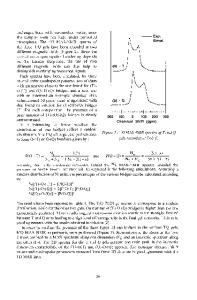Encapsulation of Ibuprofen in Mesoporous Silica: Solid State NMR Characterization
- PDF / 316,741 Bytes
- 6 Pages / 612 x 792 pts (letter) Page_size
- 42 Downloads / 380 Views
P3.26.1
Encapsulation of ibuprofen in mesoporous silica: solid state NMR characterization Florence Babonneau1*, Lydie Camus1, Nathalie Steunou1, Ainhoa Ramila2, Maria Vallet-Regi2. 1 Chimie de la Matière Condensée, UPMC/CNRS, Paris, France. [email protected] 2 Departamendo de Quimica Inorganica y Bioinorganica, Facultad de Farmacia, UCM, Madrid, Spain ABSTRACT Mesoporous silica materials have been studied for the time-dependent delivery of bioactive agents. It has already been shown that ibuprofen molecules can be encapsulated with loading as high as 30 wt% in MCM-41 silica, functionalized or not by amino groups. Interactions between the guest molecules and the host matrix have been investigated by 1H, 29Si and 13C solid state NMR spectroscopy. These experiments demonstrate an extremely high mobility of the ibuprofen molecules when the matrix is not functionalized, despite of the presence of a carboxylic function on the ibuprofen molecules. On the contrary, when the silica matrix is functionalized by amino groups, the 13C NMR response shows a strong restriction in mobility suggesting the existence of interactions between the amino groups and the carboxylic groups. INTRODUCTION Silica xerogels are attractive materials for the controlled delivery of bioactive agents as they are biocompatible and biodegradable [1-6]. Silica causes no adverse tissue reactions and degrades in the body to Si(OH)4 which is eliminated through the kidneys [7]. Therefore, a possible release of the drug without a subsequent removal of the release carrier is possible. Moreover, they present a bone bioactive behaviour as they can induce the nucleation of calcium phosphate from simulated body fluid (SBF) [3,8]. Recently, adhesion and proliferation of osteoprogenitor cells as well as differentiation of promyoblast cells along the osteogenic lineage were also reported on silica gels with pore sizes of the order of hundreds of micrometers [8]. The silica xerogels are often synthesized at low temperature and mild conditions by the solgel process. This chemical approach allows the incorporation of sensitive molecules, like proteins or therapeutics into the gel. Direct mixture of both silica sol and the drug results in heterogeneous dispersion of the drug throughout the gel, which can affect the release rate of the drug between different samples. Therefore, chemically monodisperse materials such as mesoporous MCM-41 silica possessing large specific surfaces, tunable pore sizes and volumes are particularly interesting for hosting molecules of various sizes, shapes and functionalities. Recently, the introduction of ibuprofen into MCM-41 silica and subsequently the in-vitro release process to a simulated body fluid were reported [9]. Functionalization of the pore walls by amino groups was also performed [10]. Indeed, studies performed on silica xerogels have shown that the control of the drug release depends on the chemical and physical properties of the silica matrices such as porosity and specific surfaces, water content of the gel, condensation degree
Data Loading...











